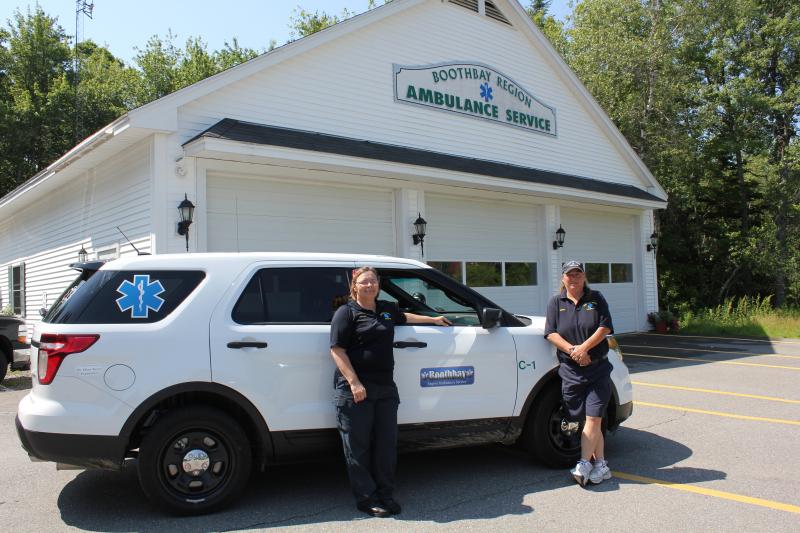Boothbay Region Ambulance Service: New mission, new vehicle

From its inception, the Boothbay Region Ambulance Service and its emergency responders have been focused on two things: keeping patients alive and getting them to hospitals and emergency rooms as quickly as possible. Although those goals haven’t changed for emergencies, the local ambulance service has now added in-home care as part of a Lincoln County community paramedicine project, which is focused on keeping residents well and at home.
BRAS Manager Scott Lash said he had been investigating community paramedicine (CP) as a way to enhance the service’s contribution to the community, fill downtime hours, and to provide more patient time to emergency technicians. Then the proposed changes at St. Andrews Hospital took center stage.
Despite the overriding need to refocus and realign local ambulance services in the wake of the emergency room closure, Lash continued to foster the community paramedicine concept locally. Last year, BRAS sought funds from the Doree Taylor Foundation to support a Boothbay Region CP project. Now with an infusion of $68,000 from the Doree Taylor Foundation and training and support from Lincoln County Healthcare, local emergency medical technicians have added wellness house calls to their duty list.
The new Ford Crown Victoria Police Interceptor is the most visible aspect of the ambulance’s service’s new role. “We went into this project thinking we would do it with what we had on hand,” Lash said. “But then the Doree Taylor grant provided funds to purchase the new vehicle and the other supplies needed. Now we have a vehicle that is less expensive to keep on the road.”
Although the CP project officially started months ago, Lash said the program’s roll-out here, where the District Nurse and LCH Home Health already manage a steady load of home care, began slowly. Local EMTs have just started to see patients regularly, but appear to be making an easy transition to the new service.
“There is an excitement on the crew’s part to be in contact with patients over and over again,” Lash said. “Pre-hospital care has been focused on getting people out of their homes and to the hospital, and now we’re in there and trying to keep them home. It’s a good perspective for our crew.”
The goal of CP programs is to reduce hospital readmissions and trips to the emergency room, and thus, lower healthcare costs. Although CP programs have been shown to reduce healthcare costs in other parts of the U.S. and in Canada, currently, Medicare and private insurers will not reimburse community paramedicine services. Without reimbursement, Lash said it’s not clear whether the project can be sustained over the long term. Although the Doree Taylor Foundation provided funding for the pilot project, it will not provide general operating funds for ongoing programs.
The Lincoln County CP project, part of a larger statewide pilot project, will be tracked to assess its success, Dr. Mark Fourre said. Fourre said data gathered through the pilot project will be useful in developing long-term revenue streams for the program.
“The concern about this not being sustainable is real, but that is the usual situation with pilot projects like this one,” Fourre said.
Lincoln County Healthcare is coordinating the CP program as an adjunct to its Home Health and Hospice program and Boothbay’s District Nurse. Requests for in-home care start with the patient’s primary care physician or at hospital discharge.
Fourre said if a patient is eligible for reimbursable Home Health services, Lincoln County Healthcare will arrange for its nurses to visit. In the Boothbay region, in cases where patients need home care but do not qualify for reimbursed services, either a community paramedic or the District Nurse will be scheduled. There is no charge for either a CP or District Nurse visit, although the District Nurse program does ask for a $10 donation.
Here, and in other communities, there has been concern about overlap between community paramedics and other home health providers. In the Boothbay region, the District Nurse has been providing in-home care for patients who might otherwise fall through the cracks for decades.
“The District Nurse sees patients in circumstances where a home visit would not be covered,” District Nurse Board President Leigh Sherrill said. “She’s part of the medical safety net for people with poor access to healthcare. The District Nurse program is still very much alive and needed in this community.”
Fourre said although community paramedics will provide many of the same services of the District Nurse, he believes the level of need and the differences between the two care providers make conflict between the programs unlikely.
“Although the District Nurse does many of the same things that the community paramedics do, she does a lot of medicine management, which is not something paramedics do,” Fourre said. “There is also only one District Nurse and she is not available on weekends, whereas ambulance crews are.”
Lash said ambulance crews will visit patients during downtime, but if there is an emergency call they will need to leave and return at a later time.
“It’s a little like DirecTV,” EMT Cathy Rumminger said. “We tell them we will be there between 8 a.m. and noon on a given day.”
Information on the community paramedicine project and referrals are available through your primary care physician or by contacting Julie Carroll, Lincoln County Healthcare, at 207-563-4158.




























